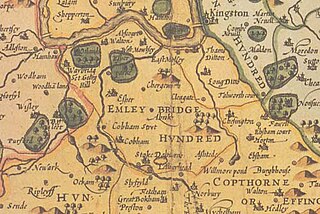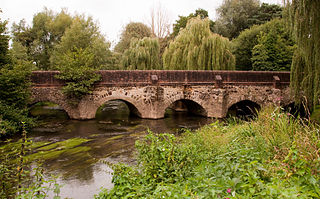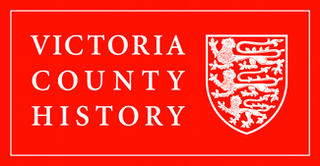
Cranleigh is a large village and civil parish, self-proclaimed the largest in England, about 8 miles (13 km) southeast of Guildford in Surrey. It lies east of the A281, which links Guildford with Horsham, on an alternative route that is not an A-road. It is in the north-west corner of the Weald, a large remnant forest, the main local remnant being Winterfold Forest directly north-west on the northern Greensand Ridge.

The Borough of Guildford is a local government district with borough status in Surrey, England. With around half of the borough's population, Guildford is its largest settlement and only town, and is the location of the council.
Frankpledge was a system of joint suretyship common in England throughout the Early Middle Ages, and High Middle Ages. The essential characteristic was the compulsory sharing of responsibility among persons connected in tithings. This unit, under a leader known as the chief-pledge or tithing-man, was then responsible for producing any man of that tithing suspected of a crime. If the man did not appear, the entire group could be fined.
The court leet was a historical court baron of England and Wales and Ireland that exercised the "view of frankpledge" and its attendant police jurisdiction, which was normally restricted to the hundred courts.

Guildford is a constituency in Surrey represented in the House of Commons of the UK Parliament since 2005 by Anne Milton, a Conservative.

Shere is a village in the Guildford district of Surrey, England 4.8 miles (7.7 km) east south-east of Guildford and 5.4 miles (8.7 km) west of Dorking, centrally bypassed by the A25. It is a small still partly agricultural village chiefly set in the wooded 'Vale of Holmesdale' between the North Downs and Greensand Ridge with many traditional English features. It has a central cluster of old village houses, shops including a blacksmith and trekking shop, tea house, art gallery, two pubs and a Norman church. Shere has a CofE infant and nursery school with 'outstanding academic results' catering for 2- to 7-year-old children which serves the village and surrounding villages and towns, and a museum which opens most afternoons at weekends.

Chilworth is a village in the Guildford borough of Surrey, England, southeast of Guildford. Chilworth has three churches, two pre-secondary education schools, an independent pub-restaurant and a railway station. The village occupies both sides of the Tillingbourne between outcrops of the Greensand Ridge including St Martha's Hill. Footpaths lead through fields and woodlands along the ranges of hills. Chilworth is split between two civil parishes, Shalford CP to the west and St Martha's CP to the east. It also has a recreation ground with a park that has a sports pavilion used for football, and an all weather table tennis table.

Wonersh is a village and civil parish in the Waverley district of Surrey, England and Surrey Hills Area of Outstanding Natural Beauty. Wonersh contains three Conservation Areas and spans an area three to six miles SSE of Guildford. In the outer London commuter belt, the village is 28 miles (45 km) southwest of London. Wonersh's economy is predominantly a service sector economy. Three architecturally-listed churches are within its boundaries as are a number of notable homes such as Frank Cook's 1905 hilltop mansion, which is a hotel, business and wedding venue.
The list of known High Sheriffs of Surrey extends back to 1066. At various times the High Sheriff of Surrey was also High Sheriff of Sussex.

The Hundred of Elmbridge or Elmbridge/Emley Hundred was a geographic subdivision in the north of the county of Surrey, England. The majority of its area forms the borough of Elmbridge in Surrey, with the remainder forming part of the Royal Borough of Kingston upon Thames in Greater London.
The Hundred of Wotton, Wotton Hundred or Dorking Hundred was a hundred in Surrey, England.

St Peter's Church is situated in Old Woking, Surrey, England. It is recorded in the Domesday Book. It also has the third oldest surviving door in the British Isles. It also has the oldest door in Surrey.
Sir Edward Braye was an English Royal Navy captain, justice of the peace, high sheriff and MP.



















